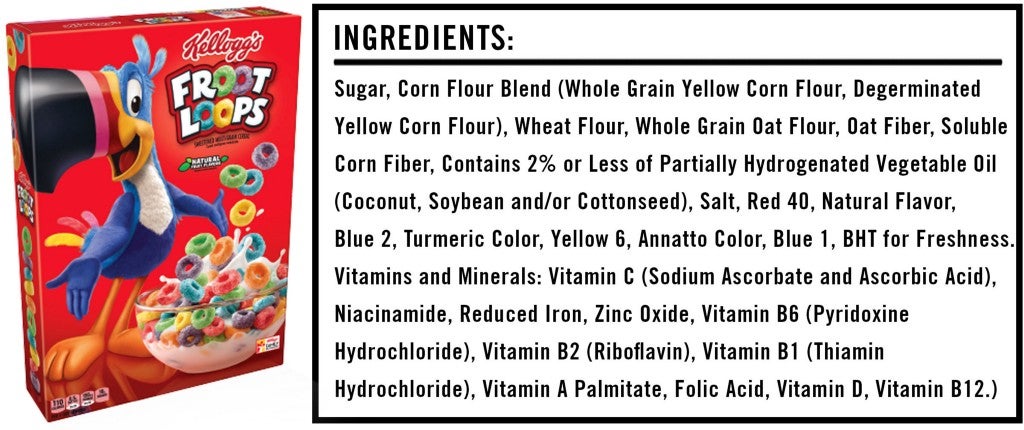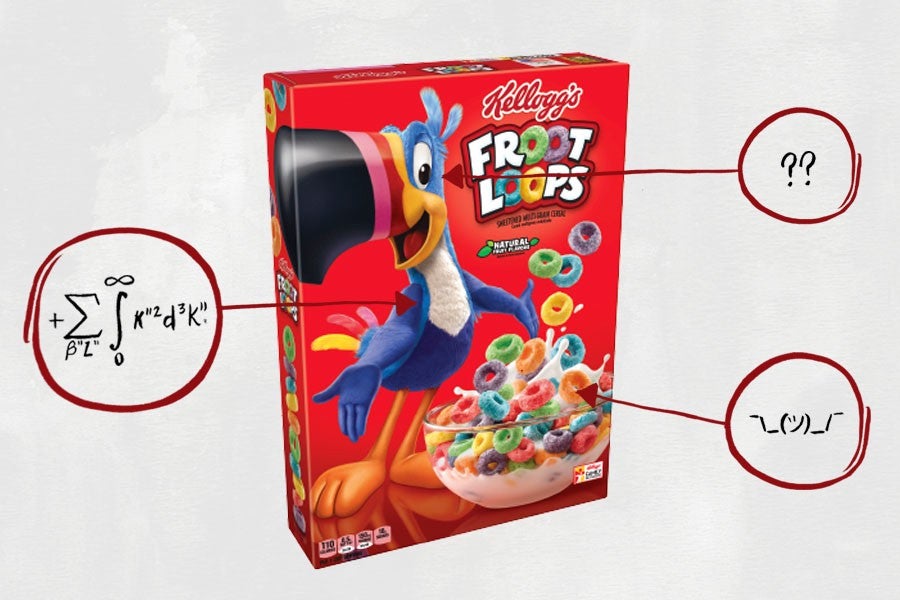We’re often told that you should never eat anything (or put anything on your body) if you don’t recognize everything on the ingredients list. But since most of us have no idea what xanthan gum or potassium benzoate are — or more importantly, what they’re doing to our bodies — we’re decoding the ingredients in the many things Americans put in (and on) themselves with the help of an expert.
This edition: Kellogg’s Froot Loops, which are made from 27 separate ingredients that we’ve broken down in the exact order they appear on their website.


The Ingredients
1) Corn Flour Blend (Whole Grain Yellow Corn Flour, Degerminated Yellow Corn Flour): This corn flour blend provides the base for these Froot Loops. Whole grain corn flour is made by grinding whole grain corn kernels, and as the seeds are being ground, the three parts of the grain are also crushed, producing a flour that contains the endosperm, the germ and the bran. Meanwhile, degerminated corn flour has the germ removed, since it’s high in oil, and therefore would otherwise turn rancid quickly if not stored in the freezer or refrigerator.
2) Sugar: One cup of Froot Loops contains 10 grams of sugar, which is a considerable amount (especially since, let’s be honest, most of us eat significantly more than a single cup at a time). The American Heart Association recommends that men consume no more than 36 grams and that women consume no more than 25 grams of added sugar per day. Too much sugar, if you didn’t already know, is terrible for you: A sugar-laden diet is associated with all kinds of ailments, from heart disease to depression. But then, these are Froot Loops — what did you expect?
3) Wheat Flour: Wheat flour is a powder made from grinding wheat. Duh.
4) Whole Grain Oat Flour: Similar to wheat flour, whole grain oat flour is a powder made from grinding oats. This is usually added to processed foods (like this cereal) as a thickener.
5) Modified Food Starch: Modified food starch is extracted from the source (corn, potato, tapioca, rice or wheat), then treated physically, enzymatically or chemically to partially break down the starch. It’s typically used as a batter to give foods a light, crispy texture.
6) Hydrogenated Vegetable Oil (Coconut, Soybean and/or Cottonseed): According to physician and biochemist Cate Shanahan, author of Deep Nutrition: Why Your Genes Need Traditional Food, consuming too much vegetable oil — which is easy to do, considering Shanahan says roughly 45 percent of the average American’s calories come from refined oils — has serious repercussions (i.e., fatty liver disease, insulin resistance and migraines). But hydrogenated vegetable oil is even worse: When you add hydrogen to food via hydrogenation — which many manufactures do to increase the food’s shelf life — you get trans fats. Unfortunately, trans fats raise cholesterol, harden arteries and inhibit the formation of an enzyme called cyclooxygenase, which helps determine the dilation of your arteries and regulates blood flow.
7) Oat Fiber: Oat fiber is made from grinding the hull of oats, which have been separated from the kernels. That means oat fiber is — for all intents and purposes — added fiber. It might also add some texture to the loops.
8) Salt: This provides flavor.
9) Soluble Corn Fiber: Similar to oat fiber, soluble corn fiber is a source of added fiber with numerous health benefits, including promoting bone strength, helping with digestion and possibly inducing weight loss.
10) Natural Flavor: Natural flavor is quite literally flavors derived from an actual food source — i.e., cherry flavoring taken from real cherries.
11) Red 40: Red 40, like many artificial colors, is known to be cancerous. But as Shanahan explained during our analysis of Doritos, studies arguing this are a bit flawed: “I’ve always been of the opinion that studies claiming artificial colors can cause cancer are irrelevant because [in the studies] they use really high amounts of the artificial colors — like, a million times more than you’d ever get [in your] food [throughout your lifetime].”
All in all, the average person’s liver should be able to break down whatever minuscule amount of artificial coloring we consume with food and drink.
12) Turmeric Extract: This contributes to the bright yellow color of these loops.
13) Blue 1: Like Red 40, Blue 1 is also known to be carcinogenic. But as Shanahan explained above, you probably don’t have to worry about the relatively tiny amounts found in your bowl of Froot Loops.
14) Yellow 6: See above.
15) Annatto Extract: Derived from the seeds of the achiote tree, annatto contributes to the red appearance of these loops.
16) BHT: Butylated hydroxytoluene (aka BHT) is a common preservative added to prevent products from spoiling. Studies continue to go back and forth about whether or not it’s carcinogenic, so it’s hard to say whether the meager amounts found in Froot Loops would cause you any harm.
17) Vitamin C (Sodium Ascorbate and Ascorbic Acid): Many cereals are reinforced with vitamins and minerals as both a marketing ploy and (maybe) an attempt to tackle widespread nutritional deficiencies, which explains why all of the following ingredients (including this one) are vitamins and minerals.
18) Niacinamide: Improves cholesterol levels and lowers cardiovascular risks.
19) Reduced Iron: Supports the circulatory system.
20) Zinc Oxide: Boosts the immune system.
21) Vitamin B6 (Pyridoxine Hydrochloride): Helps the brain create serotonin (which regulates mood) and norepinephrine (which helps the body cope with stress).
22) Vitamin B2 (Riboflavin): Aids in the breaking down of foods and regulates energy levels.
23) Vitamin B1 (Thiamine Hydrochloride): Helps the body break down carbohydrates.
24) Vitamin A Palmitate: Supports vision and the immune system.
25) Folic Acid: Helps your body produce and maintain new cells and prevents changes to DNA that may lead to cancer.
26) Vitamin B12: Keeps nerve and blood cells healthy. Low levels of vitamin B12 have also been associated with premature ejaculation, so Froot Loops surprisingly might not be the worst choice if you’re dealing with that.
27) Vitamin D3: Helps the body absorb calcium and promotes bone growth.
The Takeaway
While Froot Loops contain an array of vitamins and minerals in addition to somewhat healthy grains (like corn and oats), this cereal is also drenched in sugar and hydrogenated vegetable oil. It contains the controversial preservative butylated hydroxytoluene as well, which is never a good look.
All in all — and you probably saw this coming — less processed varieties of cereal (like those made by Ezekiel, Barbara’s or Kashi) are a better choice.
Sörry, bröther.

